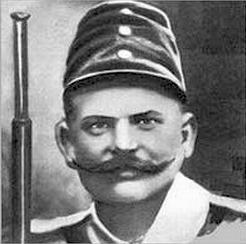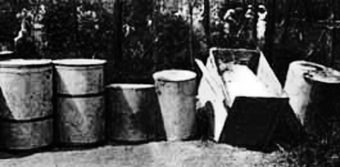The Vampire of Cinkota
 Other than the fact that he killed at least 24 people, drained them of blood, pickled them in alcohol-filled metal drums and was never caught, there isn’t a lot to say about Bela Kiss- the Vampire of Cinkota…
Other than the fact that he killed at least 24 people, drained them of blood, pickled them in alcohol-filled metal drums and was never caught, there isn’t a lot to say about Bela Kiss- the Vampire of Cinkota…
Kiss’ story begins in the town of Cinkota, Hungary (at the time about 7 miles or 11 kilometers outside of Budapest) in 1900, where he rented a house at 9 Kossuth Street. Kiss, who worked as a farrier and tinsmith, was reportedly well-liked by his neighbors, quite charming, intelligent, well read (despite no known formal schooling), and handsome, with blond hair and bright blue eyes- the latter facts seemingly helping him in his murderous exploits.
Details of Kiss’ secret life as a serial killer are, unsurprisingly, difficult to nail down, largely owing to the man himself never being brought to trial and few primary documents covering the case having survived to today. That caveat noted, it would seem approximately 11 years after arriving in Cinkota, Kiss married a woman named Marie. A year later, in 1912, Marie began an affair with an artist named Paul Bikari. Soon after, she and Bikari disappeared, with Kiss claiming the couple immigrated to America.
Shortly after his wife’s disappearance, Kiss, as with many bachelors of his era, is known to have begun frequenting various brothels (though unlike certain other serial killers, he did not target prostitutes in his murderous endeavors), as well as was regularly seen entertaining various ladies of better social repute, most of whom resided in nearby Budapest. As to this latter group, he used his charm, good looks, and classified ads in newspapers to court various women who were looking for a husband- targeting those who were particularly affluent and also who had few, if any relatives nearby.
 Soon someone in Cinkota noticed that Kiss was amassing a large collection of metal drums on his property- a fact that was reported to the police. When the collection was investigated, Kiss explained that he was storing gasoline in anticipation of upcoming rationing due to the impending war (World War I). Nobody bothered to look in the barrels.
Soon someone in Cinkota noticed that Kiss was amassing a large collection of metal drums on his property- a fact that was reported to the police. When the collection was investigated, Kiss explained that he was storing gasoline in anticipation of upcoming rationing due to the impending war (World War I). Nobody bothered to look in the barrels.
Speaking of the war, in 1914, Kiss was conscripted to fight in the Great War, assigned to the 40th Honved Infantry Brigade. Before leaving, he entrusted 9 Kossuth Street to his housekeeper, Mrs. Jakubec.
Details of exactly what happened next are conflicting, but it appears a couple years later his landlord began to believe the rumors that circulated around town that Kiss had been killed, following heavy casualties his unit endured fighting in the Carpathian Mountains. Thus, the landlord went to the house to make preparations to rent it out to another tenant. Upon arriving, he noticed an odd odor coming from the barrels. Thinking it was suspicious, he called the police to investigate. (It should be noted here though that another version of the tale states that the police simply remembered a potential gasoline cache at Kiss’ home and went to acquire it for the cause.)
However the police ended up there, details become more definitive from here, with the investigation commencing under Detective Karoly Nagy.
Over the protests of Mrs. Jakubec, the police arrived on the scene in July of 1916 and began to open the metal drums. Rather than finding gasoline, they discovered each barrel contained an extremely well preserved nude body; in total, 23 women, including his former wife Marie, and one man, Paul Bikari- the man Marie was said to have skipped town with years earlier.
Mrs. Jakubec was immediately arrested owing to suspicions concerning her ardent protest against the opening of the drums combined with the fact that Kiss had left her money in his Will; from all this, the police thought she may have been an accomplice in the murders. (She was later cleared, however.) Detective Nagy also began the search for Kiss himself, if he was still alive at all.
Looking for evidence in the house, the police discovered a room that Jakubec claimed she had been forbidden to enter in her years of service to Kiss. In the room were various letters (including 175 women writing Kiss with marriage proposals in response to his newspaper ads), an album with photos of about 70 women, and also books that touched on poisoning and strangulation.
The documents found there also seemed to indicate Kiss had been up to his murderous ways going all the way back to 1903 (eight years before he married Maria) and that two of Kiss’ ladies had brought court proceedings against him to recover money; but as both had disappeared, the proceedings were dropped (both women were found in the drums). These two ladies were widows, and they were separately reported missing after being seen in the company of a person named Hoffman (a pseudonym Kiss appears to have frequently used).
In all cases, it would seem Kiss would court various women with an eye towards stealing their money, though it’s isn’t clear whether he always killed the women he acquired money from or simply the ones who caused him legal troubles or that he couldn’t get the funds from without agreeing to marry them. Whatever the case, at least in some instances this appears to have progressed to Kiss convincing said woman to marry him, at which point he’d kill her, presumably after she gave him access to her money. For instance, one of the women was a seamstress named Katherine Varga; after being courted by Kiss, she sold her business and left Budapest with him. She was found by the police in one of his metal drums.
As for why he was subsequently dubbed the “Vampire of Cinkota,” the police discovered that Kiss had strangled each victim to death, then punctured their necks to drain their blood. After this, he pickled and sealed them in the drums. Given the exsanguination, police opined that he may have been drinking the blood, despite no hard evidence to support this speculation.
Whatever the case, after three months of searching, in October of 1916, Detective Nagy finally tracked Kiss down, though wasn’t able to bring him to justice. He found that it appeared Kiss had indeed died, with records indicating he was sent to a Serbian hospital while suffering from typhoid fever and that he succumbed to the disease.
This perhaps really was the end of Kiss, but unsubstantiated rumors spread that Kiss had swapped his body for another soldier’s in order to fake his death. Unfortunately, from here we go back to the land of poorly documented rumors. For instance, Charlotte Greig reports in the book Evil Serial Killers: In the Minds of Monsters that in 1920 a soldier in the French Foreign Legion claimed a man named Hoffman- the name Kiss once used- who fit Kiss’ description bragged one day about his skills at strangling people. When police came to investigate “Hoffman,” he supposedly fled and ultimately evaded capture. However, whether any of this part of the tale is true or not isn’t clear.
Likewise, in 1932, a New York detective named Henry Oswald swore he saw Kiss in Times Square in New York City, but nothing came of it. In 1936, there was also a rumor that Kiss, by this time in his 60s, was working as a janitor in a building on Sixth Avenue in NYC; but if he really was, police seem to have never investigated.
If you liked this article, you might also enjoy our new popular podcast, The BrainFood Show (iTunes, Spotify, Google Play Music, Feed), as well as:
- The “House of Horrors” Hotel and One of America’s First Serial Killers
- The Large Number of Human Remains Found In Ben Franklin’s Basement
- The Unsolved Case of the Murderous Belle Gunness, “Lady Bluebeard”
- How a Wife Beating, Serial Killer Puppet Gave Us the Expression “Pleased as Punch”
- The Twisted Tale of Delphine LaLaurie and Her House of Horrors
| Share the Knowledge! |
|




